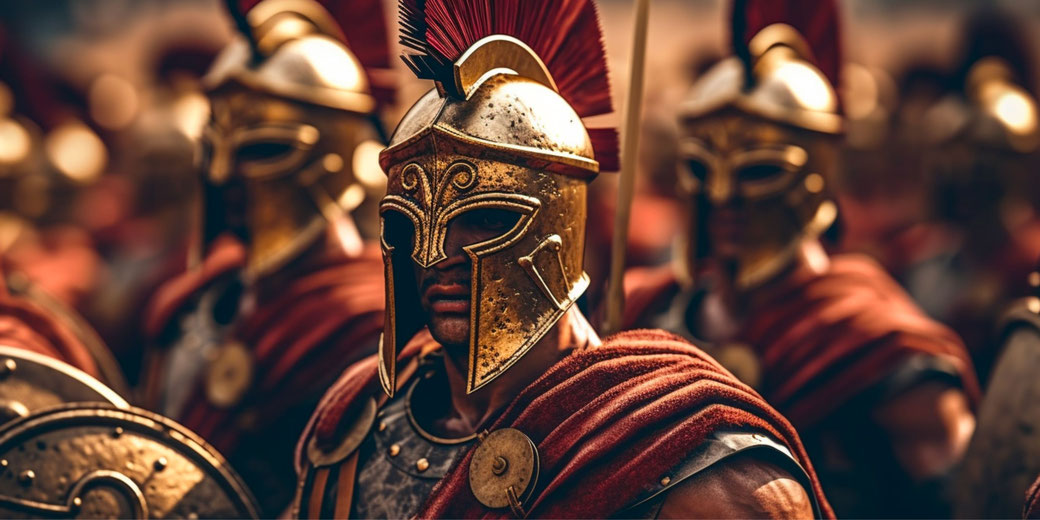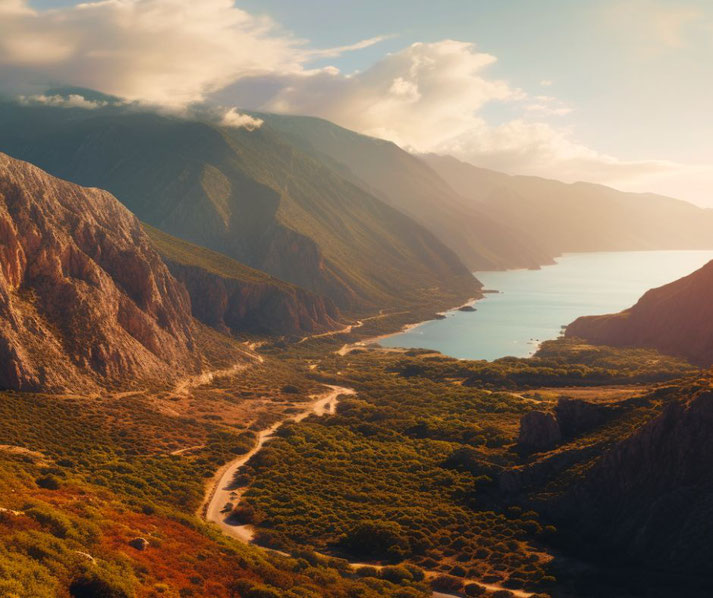The forgotten Second Battle of Thermopylae which happened 200 years after the first

The name "Thermopylae" often conjures images of King Leonidas and his 300 Spartans making their legendary stand against the Persian Empire.
Yet, two centuries after this iconic clash, the very same pass bore witness to another fierce battle, one that is often overshadowed by its more famous counterpart.
In 279 BC, instead of Persians, it was the Gallic tribes that sought passage through the narrow coastal gateway, challenging a coalition of Greek defenders.
How did this earlier battle unfold?
What set it apart from the renowned Spartan defense?
And why has it remained in the shadows of history, despite its significance?
Who were the Gauls?
The Gallic tribes, originating from Central Europe, were a collection of warlike peoples known for their fierce warriors and distinct culture.
By the 4th century BC, various factors, including internal conflicts, population pressures, and the allure of plunder, had set many of these tribes in motion, leading them on a series of migrations and invasions across the European continent.
Their journey took them through the Balkans, where they clashed with several kingdoms, leaving a trail of conquest and destruction in their wake.
The allure of the prosperous and culturally rich lands of Greece, with its famed city-states and sanctuaries, proved too tempting for the Gauls to resist.
As the Gauls approached the Greek territories, the city-states, despite their frequent internal squabbles, recognized the looming threat.
Memories of past invasions, especially the Persian onslaught, were still fresh in the collective Greek memory. The need for a united front became evident.
The Aetolian League, a confederation of city-states in central Greece, took the lead in organizing a defense.
They were soon joined by the Boeotians, Athenians, and Phocians, each bringing their unique strengths and strategies to the table.
This coalition was not just a military alliance; it symbolized the shared values, traditions, and the very essence of Hellenic identity that they were all determined to defend.

Why were the Gauls in Greece?
The Gallic tribes' decision to invade Greece was not a sudden impulse but rather the culmination of a series of migrations and conquests that had seen them traverse vast swathes of Europe.
Their journey began in Central Europe, driven by a combination of socio-economic pressures, tribal rivalries, and an insatiable appetite for plunder.
As they moved southwards, the Balkans bore witness to their might, with many regions succumbing to their martial prowess.
The tales of Greek prosperity, the allure of its famed treasures, and the promise of its fertile lands beckoned the Gauls, drawing them closer to the heart of the Hellenic world.
As they entered Greek territories, the Gauls employed a strategy of swift and brutal raids, targeting towns and sanctuaries alike.
Their approach was marked by a combination of military strategy and sheer audacity.
Cities that resisted were besieged, and those that surrendered faced plunder. The sanctity of religious sites was no deterrent for the Gauls; in their eyes, these were troves of wealth waiting to be seized.
This audacious approach not only enriched the Gallic war chests but also sowed fear and uncertainty among the Greek populace.
The rush to form a united defense
In the face of the Gallic threat, the Greek city-states showcased a remarkable ability to set aside their differences and unite under a common cause.
Historically, these city-states were fiercely independent entities, often embroiled in disputes and wars against each other.
Yet, the gravity of the external threat posed by the Gauls catalyzed a sense of shared identity and purpose among them.
The very essence of what it meant to be Greek, with shared cultural, religious, and philosophical foundations, became the rallying cry for a united defense.
The Aetolian League, a confederation of city-states in central Greece, emerged as a pivotal player in this collective defense.
Renowned for their military prowess and strategic acumen, the Aetolians were quick to recognize the magnitude of the Gallic threat. They reached out to their neighbors, urging unity and collaboration.
The Boeotians, known for their skilled hoplites and cavalry, heeded the call, bringing their considerable military strength to the coalition.
Athens, the famed city-state with its rich naval history and democratic ideals, also joined the alliance, understanding the broader implications of a Gallic conquest.
The Phocians, with their intimate knowledge of the local terrain, especially around the Thermopylae region, became invaluable allies, providing both troops and strategic guidance.

What happened in the Second Battle of Thermopylae?
The stage was set at Thermopylae, a narrow coastal passage that had once before witnessed the indomitable spirit of the Greeks against overwhelming odds.
As the Gauls approached, the significance of this battleground was not lost on either side.
For Brennus and his Gallic warriors, Thermopylae was the gateway to the riches of southern Greece.
For the Greeks, it was a natural fortress, a place where a well-coordinated defense could hold back even the most formidable of armies.
The united Greek forces, leveraging their knowledge of the terrain, set up defensive positions to exploit the narrowness of the pass.
The strategy was clear: use the confined space to neutralize the numerical advantage of the Gauls and engage them in close combat, where the famed Greek phalanx could be most effective.
The Aetolians, Boeotians, Athenians, and Phocians, each brought their unique strengths to the battlefield, creating a cohesive defensive unit.
The hoplites, with their large shields and long spears, formed the frontline, ready to repel the Gallic onslaught.
As the battle commenced, the Gauls, confident in their numbers and recent victories, charged headlong into the Greek defenses.
However, the narrowness of the pass and the disciplined Greek formations proved challenging.
Waves after waves of Gallic warriors were repelled, with the Greeks leveraging their superior tactics and the advantages of the terrain.
The fighting was fierce, with both sides suffering heavy casualties. Yet, the Greeks, driven by a determination to protect their homeland and inspired by past victories at this very location, held their ground.

The Gallic attack on Delphi
Delphi, nestled on the slopes of Mount Parnassus, was more than just a city in ancient Greece; it was the spiritual and cultural heart of the Hellenic world.
Home to the revered Oracle of Delphi, it was a place where kings and commoners alike sought divine guidance.
Its sanctity was recognized across the Greek world, and its treasures, both material and spiritual, were legendary.
For the Gauls, still reeling from the challenges faced at Thermopylae and driven by their insatiable appetite for plunder, Delphi presented an irresistible target.
As the Gallic forces approached Delphi, they were met not just by its defenders but also by the weight of its spiritual significance.
The Greeks believed that Delphi was protected by the god Apollo himself, and tales of its divine protection were part of Hellenic lore.
The defenders of Delphi, bolstered by this belief and understanding the profound cultural and religious significance of their charge, prepared to resist the Gallic onslaught with unmatched fervor.
The battle for Delphi was fierce. The Gauls, seeing the city's treasures within their grasp, launched wave after wave of attacks.
However, the rugged terrain, combined with the determined resistance of the Delphians and their allies, made the conquest challenging.
Legend has it that during the battle, the Greeks were aided by divine interventions – from mysterious sounds echoing through the mountains, believed to be the god Apollo and his divine cohorts, to sudden shifts in weather that hampered the Gallic advance.
In the end, the Gauls were repelled, and Delphi remained unconquered. The attempted sack of the city became a symbol of Greek resilience and the protective power of their gods.
For the Gauls, the failure to capture Delphi was a significant blow, further dampening their ambitions in Greece.
What happened to Brennus and the remaining Gauls?
Brennus, according to ancient sources, was gravely wounded during the assault on Delphi.
Unable to bear the pain of his injuries and the weight of his failure, he is said to have taken his own life by drinking wine mixed with poison.
The remaining Gauls, facing heavy losses and demoralization, decided to retreat. They moved away from central Greece, and many of them migrated further east.
A significant number of these Gauls eventually settled in Asia Minor, specifically in the central part of modern-day Turkey.
They established a region known as Galatia. The Galatians, as they came to be known, maintained their distinct Celtic customs and identity for several centuries, even as they interacted with the surrounding cultures.
Over time, the Galatians became involved in the broader geopolitical events of the region.
They had interactions with famous figures like Alexander the Great and were eventually incorporated into the Roman Empire.
The legacy of the Gauls in Galatia persisted, and they are even mentioned in the New Testament of the Bible, in the Epistle to the Galatians written by the Apostle Paul.
What do you need help with?
Download ready-to-use digital learning resources
Copyright © History Skills 2014-2024.
Contact via email
With the exception of links to external sites, some historical sources and extracts from specific publications, all content on this website is copyrighted by History Skills. This content may not be copied, republished or redistributed without written permission from the website creator. Please use the Contact page to obtain relevant permission.





